Introduction to Classical Music
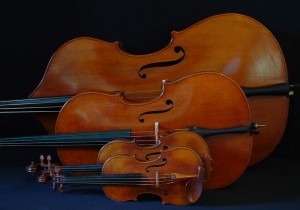
The Strings
I’ve been a professional classical musician for more decades than I care to disclose. By far the most common comment I’ve heard (other than, “Why, that cello is bigger than you are!) is— “I don’t know anything about classical music. I like it, but I just don’t understand it.”
I invite these doubtful audience members to relax and listen. I assure them that one doesn’t necessarily need to “know” anything to enjoy the music.
In an attempt to rectify this seemingly insurmountable obstacle for some people toward classical music, I’m embarking on a series for the uninitiated, which we will call Music 101. I will devise some interesting materials and quizzes so that people new to certain classical repertory will know what to listen for. I hope to cover, with the help of my fellow Interlude writers: Everything You Always Wanted to Know About Music. Don’t be afraid to ask about particular questions you are burning to have explained.
Introducing the Orchestral Instruments
First, I thought we should start with the instrument families of the orchestra.
The strings are by far the largest group of instruments in the orchestra—the violins, the violas, the cellos and the double basses. All of the stringed instruments are played with a bow, strung with horsehair. The larger the instrument the lower is their sound. Their four strings get thicker and longer too of course. They are beautiful works of art, carefully hand crafted of wood. The older instruments are like fine wines that have aged, honing their beautiful sound. Some of the most coveted stringed instruments of a maker hailing from Cremona Italy, (and the most expensive), are those made by Italian master luthier, Antonio Stradivarius (1644-1737.) He is considered the most significant artisan in the field. It is estimated that Stradivarius made 1,000 to 1100 instruments— violins, violas, cellos and even harps and guitars—and today we are lucky that 650 instruments survive. The varnish that he used on the surfaces of the wood defies analysis even to this day.
Guarneri is the family name of distinguished luthiers also from Cremona, Italy in the 17th and 18th centuries whose standing is comparable to the Stradivarius family. Guarneri del Gesu (1698-1744) made remarkable violins. Many world-class violinists prefer the instruments of Guarneri to Strads! Anne Akiko Meyers owns the “Molitor” Strad and just recently Meyers received the lifetime use of the “Vieuxtemps” Guarneri del Gesu, purchased for her by an anonymous buyer.
Among cellists, two names stand out. Dominico Montagnana (1686-1750) was an Italian master from Venice whose cellos are regarded as exquisite. Lynn Harrell has just announced that he is going to sell his beloved Montangana cello, an instrument he has played on for fifty years. Matteo Goffriler, also Venetian, is particularly noted for his cellos. His cello from 1733 belonged to the great cellist Pablo Casals, which he acquired in 1913 and played throughout his life until his death in 1973. From 1950-1965 Janos Starker played and recorded on the “Aylesford” Stradivarius. In 1965 Starker acquired a Goffriller cello made in Venice in 1705, which he owns to this day.

The Woodwinds
Now perhaps you can understand a string player’s reticence to allow anyone to even get near our instruments. Although most of us play instruments of lesser quality, it is like walking around with a priceless one-of-a-kind painting and they are beloved family members.
The woodwinds include the flute, clarinet, oboe, and bassoon and their relatives—the piccolo, the alto and bass flute, the bass clarinet, the basset horn, (clarinet family) the English horn (oboe family) and the contra-bassoon. Once again, the lower frequency instruments are larger. The oboe, clarinet and bassoon are played with reeds—pieces of painstakingly shaped and scraped cane. Usually the oboe and bassoon players shape their own reeds, as the behavior of the reed is the primary factor in the oboe’s quality of sound including the pitch, and the tone quality. The reed contributes to the ease of the production of the sound. Ask any oboe player and they will tell you that they spend unbelievable numbers of hours soaking, binding and scraping reeds, some specifically shaped for certain pieces of music, and even up to the moment before they play. An entire toolkit is required for this process.
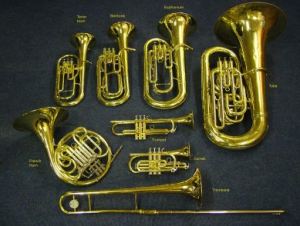
The Brass
The brass instruments are easily identifiable. They are the loudest instruments and are made of the shiny metal— consisting of the trumpets, French Horn, trombone and tuba and their relatives: Piccolo trumpet, cornet and flugelhorn (trumpet family) the euphonium (tuba family) and the more rare Tuben or Wagner horn, which combines elements of the French Horn and the tuba. This instrument was created specifically for Wagner’s’ operatic Ring cycle. French horn players typically play the Wagner tuben. The tuben are finicky instruments, which also appear in the Bruckner Symphonies.
And the granddaddy is the cimbasso! This instrument is in the trombone family The cimbasso encompasses a similar range to the tuba or bass trombone and is played rarely.
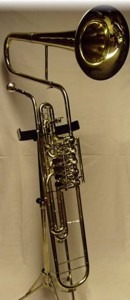
Cimbasso
The percussion family includes any number of instruments to bang, scrub or scrape with mallets or sticks, or to shake and whirl. They are considered to be the oldest musical instruments after the human voice. The orchestra percussion section might include additional instruments that are not strictly percussion instruments per se, like whistles, sirens, bells, and tuned instruments such as the marimba, xylophone, glockenspiel and vibraphone. The timpani or kettledrums belong to their own subgroup as they are tuned to certain pitches. Usually a timpanist is hired in addition to the percussion players. When you see the timpanist lean down as if to put their cheek on the instrument it is to hear the tuning.
Keyboard instruments do make their appearance in the orchestra as well—the piano, celeste, harpsichord and organ.
And finally the harp is a multi-stringed instrument generally categorized in the stringed instrument group but it has its own category. Although there are many sizes of harps including folk, lap and Celtic instruments, the orchestral harp is a large instrument requiring heavy lifting. It has a frame, sound-board and pedals so the instrument can play in different keys. During contemporary music you will see a lot of fancy footwork from the harp player while both of their hands strum the strings.
Benjamin Britten’s A Young Person’s Guide to the Orchestra is a wonderful piece, written to highlight each individual orchestral section separately.
Guide to Music Reading
Reading music is like learning another language. The markings in the sheet music include established symbols. In addition to signs that indicate the time signature, the clef and key signature, we have symbols to indicate length of notes, pauses, tempo markings and dynamic markings, as well as markings for the direction of the bow movements. The tempo marking at the beginning of a movement sometimes indicates speed as well as character. For example, andante means gently as well as slowly. Additionally, the composer often uses either Italian or German words within the piece of music to indicate mood, style or interpretation. We become adept at reading all of these indications simultaneously. Fingerings, though, are typically a matter of a player’s preference.
Of course this is secondary to the task of mastering our instrument! We must learn to coordinate our two hands and/or lips, mouth and fingers to produce a mesmerizing sound. Once we can do that and read the music, then the interpretation can begin. The conductor indicates the emotion and passion with his or her movements, stick technique and facial expressions, to produce one unified concept.
The music is about conveying a mood or emotion. Our response is always subjective as with other art. As individuals what it may conjure up for me might be different for you and even that of the composer. Think of the last movie or theater production that you went to. The music assists in depicting the emotions in the movie—it may inspire feelings such as agitation, apprehension, remorse, bitterness, and elation. It may evoke memories. Just let it wash over you so that you and it will allow you to create your own visual images.


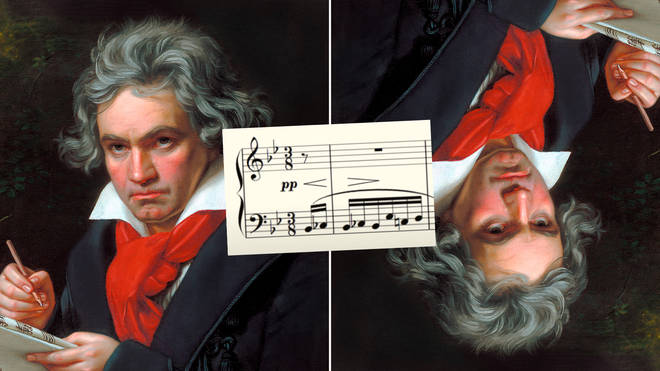


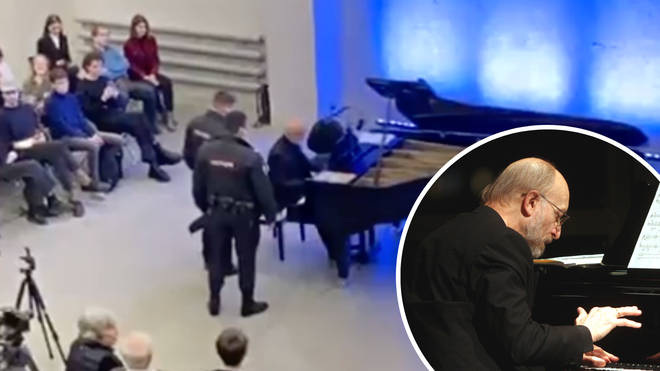
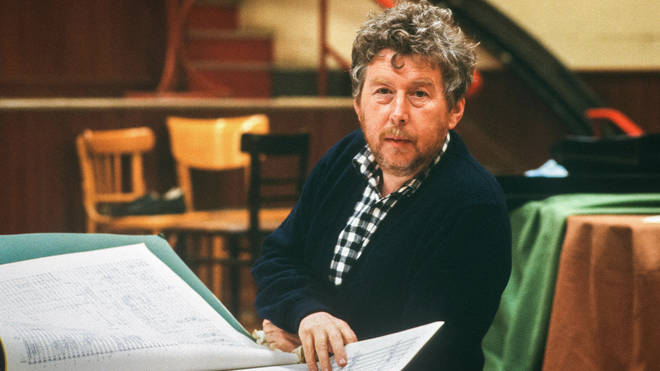

 I just love historical costume dramas, and the story of this fantastic film is based on the life of children’s author and illustrator Beatrix Potter, who created one of the most loveable and endearing Easter characters in “Peter Rabbit.” Starring Renée Zellweger and Ewan McGregor, the film features animated sequences with characters from her stories.
I just love historical costume dramas, and the story of this fantastic film is based on the life of children’s author and illustrator Beatrix Potter, who created one of the most loveable and endearing Easter characters in “Peter Rabbit.” Starring Renée Zellweger and Ewan McGregor, the film features animated sequences with characters from her stories.
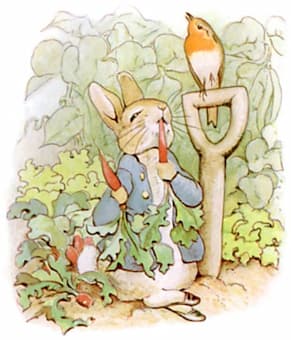
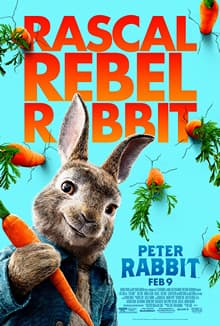 Set in the Lake District of England, Peter Rabbit, his cousin Benjamin Bunny and the sisters Flopsy, Mopsy and Cottontail, are stealing vegetables from Mr. McGregor, who had killed and eaten their father. After McGregor suddenly dies of a heart attack, Peter invites all the local animals to take over McGregor’s manor. The manor is inherited by Thomas McGregor, who kicks out Peter and the other animals and upgrades the security of the garden. Peter and Benjamin sneak back in, and an enraged Thomas buys and electric fence and dynamite to keep out the rabbits. Meanwhile, Thomas falls in love with Bea, a local resident who has been kind to Peter and all rabbits. Things get predictably out of control, but in the end Thomas and Bea resume their relationship and they allow wildlife to take from the garden. The soundtrack to the movie features 28 soundtrack songs, including a version of the song “Steal My Sunshine” by the band Len with the lyrics rewritten to be about Peter Rabbit. And just in case, in 2021 the sequel “Peter Rabbit 2: The Runaway” was released, and now Thomas and Bea are married and live with Peter and his rabbit family. Bored at home, Peter goes to the big city, where he meets shady characters and ends up creating chaos for the entire family.
Set in the Lake District of England, Peter Rabbit, his cousin Benjamin Bunny and the sisters Flopsy, Mopsy and Cottontail, are stealing vegetables from Mr. McGregor, who had killed and eaten their father. After McGregor suddenly dies of a heart attack, Peter invites all the local animals to take over McGregor’s manor. The manor is inherited by Thomas McGregor, who kicks out Peter and the other animals and upgrades the security of the garden. Peter and Benjamin sneak back in, and an enraged Thomas buys and electric fence and dynamite to keep out the rabbits. Meanwhile, Thomas falls in love with Bea, a local resident who has been kind to Peter and all rabbits. Things get predictably out of control, but in the end Thomas and Bea resume their relationship and they allow wildlife to take from the garden. The soundtrack to the movie features 28 soundtrack songs, including a version of the song “Steal My Sunshine” by the band Len with the lyrics rewritten to be about Peter Rabbit. And just in case, in 2021 the sequel “Peter Rabbit 2: The Runaway” was released, and now Thomas and Bea are married and live with Peter and his rabbit family. Bored at home, Peter goes to the big city, where he meets shady characters and ends up creating chaos for the entire family.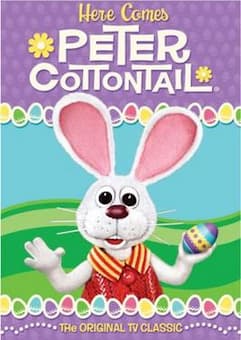 A more loveable version of Peter Rabbit became the subject of an animated television special in 1971. The young Easter Bunny Peter Cottontail lives in April Valley together with his fellow Easter Bunnies. They make Easter candies, sew bonnets, and they decorate and deliver Easter eggs. But trouble starts brewing when Peter Cottontail, who is somewhat unreliable and gossipy, is supposed to be appointed Chief Easter Bunny. An evil rabbit named January Q. Irontail also wants the job, but his motivation is a little different. He wants to ruin Easter for children as revenge for a child roller-skating over his tail. Now he has to wear an artificial tail, and he is not a happy bunny. After much intrigue, scheming, and treachery, Irontail does become the new Chief Easter Bunny. He quickly passes various laws to make Easter a disaster. Eggs have to be painted brown and gray, candy sculptors become tarantulas and octopuses, and instead of Easter bonnets, he orders that Easter rubber boots be made. Of course, things do work out in the end, and Cottontail, all reformed and reliable becomes the official Chief Easter Bunny. It is one of my favourite animated films, and the song “Here comes Peter Cottontail,” written by Walter E. Rollins and Steve Nelson, became a huge hit.
A more loveable version of Peter Rabbit became the subject of an animated television special in 1971. The young Easter Bunny Peter Cottontail lives in April Valley together with his fellow Easter Bunnies. They make Easter candies, sew bonnets, and they decorate and deliver Easter eggs. But trouble starts brewing when Peter Cottontail, who is somewhat unreliable and gossipy, is supposed to be appointed Chief Easter Bunny. An evil rabbit named January Q. Irontail also wants the job, but his motivation is a little different. He wants to ruin Easter for children as revenge for a child roller-skating over his tail. Now he has to wear an artificial tail, and he is not a happy bunny. After much intrigue, scheming, and treachery, Irontail does become the new Chief Easter Bunny. He quickly passes various laws to make Easter a disaster. Eggs have to be painted brown and gray, candy sculptors become tarantulas and octopuses, and instead of Easter bonnets, he orders that Easter rubber boots be made. Of course, things do work out in the end, and Cottontail, all reformed and reliable becomes the official Chief Easter Bunny. It is one of my favourite animated films, and the song “Here comes Peter Cottontail,” written by Walter E. Rollins and Steve Nelson, became a huge hit.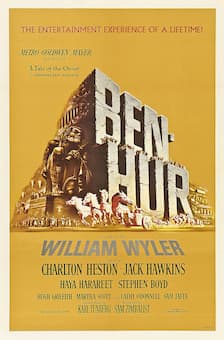
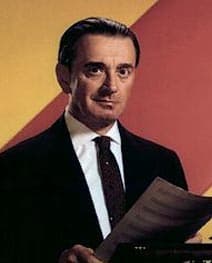
 Easter films have long delighted children and adults alike. In some cases, however, they have also courted controversy. The great film director Martin Scorsese shocked many Christian religious groups with his The Last Temptation of Christ of 1988. The film depicts the life of Jesus Christ and his struggle with various forms of temptation including fear, doubt, depression, reluctance, and lust. Christ is tempted by imagining himself engaged in sexual activities as he had an undisclosed prior relationship with Mary Magdalene, a Jewish prostitute. While on the cross, Jesus is in a state of hallucination and he perceives that God wants him to be happy. An angel brings him down off the cross and, invisible to others, takes him to Mary Magdalene, whom he marries. They are soon expecting a child and living an idyllic life, but she abruptly dies. Next he takes Mary and Martha, the sisters of Lazarus, for his wives. He starts a family with them, having many children, and lives his life in peace. When he finds himself on the cross once more, he has overcome the last temptation of escaping death.
Easter films have long delighted children and adults alike. In some cases, however, they have also courted controversy. The great film director Martin Scorsese shocked many Christian religious groups with his The Last Temptation of Christ of 1988. The film depicts the life of Jesus Christ and his struggle with various forms of temptation including fear, doubt, depression, reluctance, and lust. Christ is tempted by imagining himself engaged in sexual activities as he had an undisclosed prior relationship with Mary Magdalene, a Jewish prostitute. While on the cross, Jesus is in a state of hallucination and he perceives that God wants him to be happy. An angel brings him down off the cross and, invisible to others, takes him to Mary Magdalene, whom he marries. They are soon expecting a child and living an idyllic life, but she abruptly dies. Next he takes Mary and Martha, the sisters of Lazarus, for his wives. He starts a family with them, having many children, and lives his life in peace. When he finds himself on the cross once more, he has overcome the last temptation of escaping death.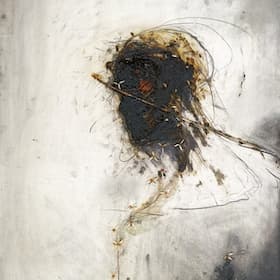
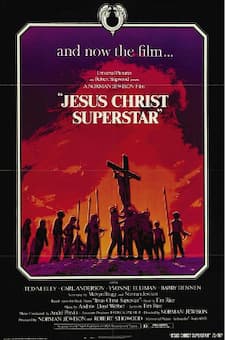 The story of Easter also made it into the 1971 rock opera Jesus Christ Superstar. The plot is loosely based on the Gospel accounts of the Passion, but it explores and interprets the psychology of Jesus and other characters, with much of the plot centering on Judas. Judas is really unhappy with the direction in which Jesus is steering his disciples. Religious groups condemned the initial Broadway show and subsequent productions, and the rock opera was banned in Hungary. Andrew Lloyd Webber, frequently called the “most commercially successful composer in history,” composed the musical score.
The story of Easter also made it into the 1971 rock opera Jesus Christ Superstar. The plot is loosely based on the Gospel accounts of the Passion, but it explores and interprets the psychology of Jesus and other characters, with much of the plot centering on Judas. Judas is really unhappy with the direction in which Jesus is steering his disciples. Religious groups condemned the initial Broadway show and subsequent productions, and the rock opera was banned in Hungary. Andrew Lloyd Webber, frequently called the “most commercially successful composer in history,” composed the musical score.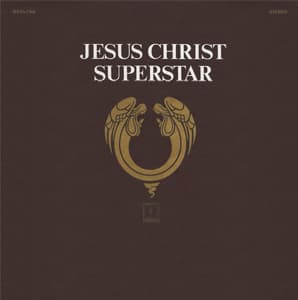 Several of his musicals have run for more than a decade in the West End and on Broadway, and surely you know such hit songs as “The Music of the Night” from The Phantom of the Opera, “Don’t Cry for Me Argentina” from Evita, and “Memory” from Cats. Jesus Christ Superstar was one of his earlier projects, and audiences were rather shocked by the controversial portrayals of Mary Magdalene, and her unrequited love for Jesus. Yet, many of the most popular tunes from this rock opera have gained independence and stormed the pop hit charts.
Several of his musicals have run for more than a decade in the West End and on Broadway, and surely you know such hit songs as “The Music of the Night” from The Phantom of the Opera, “Don’t Cry for Me Argentina” from Evita, and “Memory” from Cats. Jesus Christ Superstar was one of his earlier projects, and audiences were rather shocked by the controversial portrayals of Mary Magdalene, and her unrequited love for Jesus. Yet, many of the most popular tunes from this rock opera have gained independence and stormed the pop hit charts.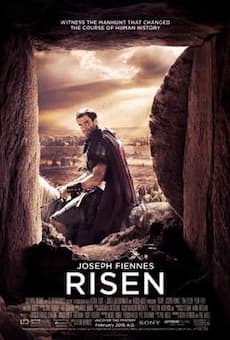 For a number of years, audiences were glued to their Netflix accounts in order to watch the unfolding dramas offered by “Game of Thrones.” If you throw “Game of Thrones” in a blender and mix it with the 2000 epic historical drama “Gladiator,” the outcome is something like the 2016 biblical drama film “Risen.” Directed by Kevin Reynolds and starring Joseph Fines, and Tom Felton, it is a historical detective story as the Roman Centurion Clavius is on the hunt for Jesus’ body after it mysteriously disappears following his crucifixion.
For a number of years, audiences were glued to their Netflix accounts in order to watch the unfolding dramas offered by “Game of Thrones.” If you throw “Game of Thrones” in a blender and mix it with the 2000 epic historical drama “Gladiator,” the outcome is something like the 2016 biblical drama film “Risen.” Directed by Kevin Reynolds and starring Joseph Fines, and Tom Felton, it is a historical detective story as the Roman Centurion Clavius is on the hunt for Jesus’ body after it mysteriously disappears following his crucifixion.
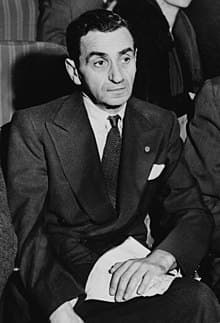
 The film features Broadway star Don Hewes played by Fred Astaire who has just lost his dancing partner Ann Miller. So he declares that he can make a hit performer out of the next dancer he sees. This turns out to be the inexperienced Hannah (Judy Garland), who bristles as Don tries to make her into his old partner. But as he realizes that he is falling in love with Hannah, Don knows that he must let her grow into her own kind of dancer if he wants her to reach her full potential. With the music composed by
The film features Broadway star Don Hewes played by Fred Astaire who has just lost his dancing partner Ann Miller. So he declares that he can make a hit performer out of the next dancer he sees. This turns out to be the inexperienced Hannah (Judy Garland), who bristles as Don tries to make her into his old partner. But as he realizes that he is falling in love with Hannah, Don knows that he must let her grow into her own kind of dancer if he wants her to reach her full potential. With the music composed by 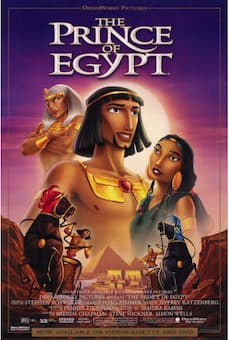 When it comes to animation, my favorite Easter-themed movie has to be “The Prince of Egypt.” It tells the story of the Book of Exodus in a very entertaining way as it follows the life of Moses. Essentially it depicts the first Passover, a holiday that regularly overlaps with Easter. In the event, Moses, Miriam, Aaron and Tzipporah lead the Hebrews out of Egypt. At the Red Sea, the Hebrews discover that a vengeful Rameses is pursuing them with his army, intent on killing them. However, a pillar of fire blocks the army’s way, while Moses uses his staff to part the sea. The Hebrews cross the open sea bottom; the fire vanishes and the army gives chase, but the sea closes over and drowns the Egyptian soldiers, sparing Rameses alone. Moses sadly bids his brother farewell and leads the Hebrews to Mount Sinai, where he receives the Ten Commandments.
When it comes to animation, my favorite Easter-themed movie has to be “The Prince of Egypt.” It tells the story of the Book of Exodus in a very entertaining way as it follows the life of Moses. Essentially it depicts the first Passover, a holiday that regularly overlaps with Easter. In the event, Moses, Miriam, Aaron and Tzipporah lead the Hebrews out of Egypt. At the Red Sea, the Hebrews discover that a vengeful Rameses is pursuing them with his army, intent on killing them. However, a pillar of fire blocks the army’s way, while Moses uses his staff to part the sea. The Hebrews cross the open sea bottom; the fire vanishes and the army gives chase, but the sea closes over and drowns the Egyptian soldiers, sparing Rameses alone. Moses sadly bids his brother farewell and leads the Hebrews to Mount Sinai, where he receives the Ten Commandments.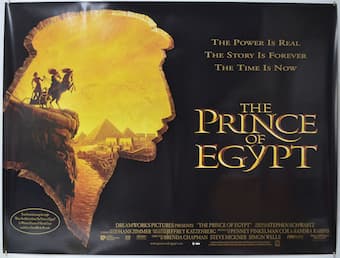 The story of Moses’s deliverance of the Israelites is generally considered a biblical foreshadowing that parallels the death and resurrection of Jesus. Composer Stephen Schwartz wrote the songs for the film, and they were arranged and produced by Hans Zimmer for the film score. Various tracks feature contemporary artists such as K-Ci & JoJo and Boyz II Men, and also include the fabulous Mariah Carey and Whitney Houston duet “When You Believe,” a Babyface rewrite of the original Schwartz composition, sung by Michelle Pfeiffer and Sally Dworsky in the film.
The story of Moses’s deliverance of the Israelites is generally considered a biblical foreshadowing that parallels the death and resurrection of Jesus. Composer Stephen Schwartz wrote the songs for the film, and they were arranged and produced by Hans Zimmer for the film score. Various tracks feature contemporary artists such as K-Ci & JoJo and Boyz II Men, and also include the fabulous Mariah Carey and Whitney Houston duet “When You Believe,” a Babyface rewrite of the original Schwartz composition, sung by Michelle Pfeiffer and Sally Dworsky in the film. To conclude this little blog on the 10 Greatest Easter Movies let’s get a little silly and look at the hilarious comedy “Hank and Mike.” Mike and Hank are two blue-collar Easter Bunnies and things get dicey when the corporation that owns all holidays decides to make some serious cutbacks. Hank and Mike get fired, and try to find different jobs with devastating result. As they miserably fail at everything they touch, they are fighting depression, debt and eventually each other. Finally, they make it their mission to get their jobs back, get the girls they love, and settle the score. Talking about score, the funky music was provided by the eclectic Phil Electric. Whatever movie tickles your fancy, I hope you will enjoy a Happy Easter!
To conclude this little blog on the 10 Greatest Easter Movies let’s get a little silly and look at the hilarious comedy “Hank and Mike.” Mike and Hank are two blue-collar Easter Bunnies and things get dicey when the corporation that owns all holidays decides to make some serious cutbacks. Hank and Mike get fired, and try to find different jobs with devastating result. As they miserably fail at everything they touch, they are fighting depression, debt and eventually each other. Finally, they make it their mission to get their jobs back, get the girls they love, and settle the score. Talking about score, the funky music was provided by the eclectic Phil Electric. Whatever movie tickles your fancy, I hope you will enjoy a Happy Easter!.jpg)
.jpg)